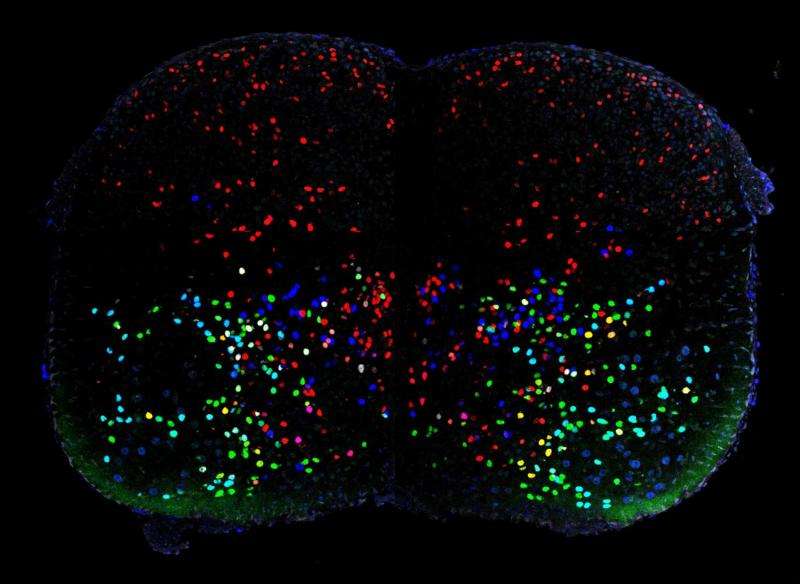How many types of neurons are there in the brain?

For decades, scientists have struggled to develop a comprehensive census of cell types in the brain. Now, in a pair of companion papers, researchers at Columbia's Mortimer B. Zuckerman Mind Brain Behavior Institute describe powerful new approaches to systematically identify individual classes of brain cells, or neurons, in the spinal cord. In doing so, they reveal elements of the underlying circuit architecture through which these neurons shape movement—and highlight how statistical approaches could provide neuroscientists with a critical tool to quantify the cellular diversity of any region of the brain.
The papers are published today online in the journal Cell.
"Our work allows scientists to assess the diversity of neuronal cell classes in specific regions of the central nervous system—in part by plugging basic cellular characteristics into this fundamental statistical model," said Thomas M. Jessell, PhD, senior author on one of the papers and a co-director of the Zuckerman Institute. "As we continue to build upon and refine this method, scientists could take any cellular circuit and reveal its basic component parts. And once we understand the brain at this level, there are key problems of circuitry and function that can be addressed at a detailed level of resolution."
In today's newly published research, scientists focused on a group of neurons in the spinal cord called V1 interneurons, which form connections that orchestrate the activity and output of motor neurons, the class of neurons that give us the power to move.
"Motor neurons are like the strings of a marionette, with interneurons directing which strings are to be pulled, and in what order," said Jay Bikoff, PhD, a postdoctoral scholar at Columbia and first author of one of the papers. "Previous studies had shown that V1 interneurons are intimately involved in shaping motor neuron activity, but had been unable to determine precisely how they did so. We needed to classify the varieties of V1 interneurons in a much more systematic and detailed manner—information that would then help to decipher the circuits that underlie movement at an unprecedented organizational level."
There are many characteristics that distinguish one type of neuron from another, such as where it is located or what it looks like. But ultimately, the researchers argue, a neuron can be defined by its genetic identity.
"While at its core every neuron essentially contains the same genetic information, differences between the genes that are switched on, and those that remain dormant confer neurons with individual identities, like a fingerprint," said Mariano Gabitto, a doctoral candidate at Columbia in the department of neuroscience and the first author of the second paper. "So if you have a neuron's fingerprint, you can then use it to distinguish one class of neuron from the next, which is critical for dissecting the functional organization of the nervous system."
In this research, the scientists focused on finding that fingerprint. By studying the V1 interneurons of laboratory mice, researchers first identified 19 genetic 'switches,' called transcription factors, which—when activated in a particular combination—made the genetic profile of one V1 interneuron class different from another. What the scientists needed to do next was match the unique pattern of transcription factors to a particular type of interneuron, a feat that proved difficult with traditional experimental techniques.
Faced with this challenge, the researchers turned to theoretical neuroscientist Larry Abbott, PhD, and statistician Liam Paninski, PhD—colleagues at Columbia's Zuckerman Institute—as well as Ari Pakman, PhD, a postdoctoral fellow in Dr. Paninski's lab and co-first author in the second paper, to build a more powerful statistical model. Drs. Abbott and Paninski developed a mathematical approach based on Bayesian regression analysis that provides the ability to account for uncertainty in a principled way, while also incorporating the complex genetics of the 19 transcription factors. Using this statistical model the research team was able to distinguish 50 distinct types of V1 interneurons—results that withstood even the toughest statistical and experimental scrutiny.
"Not only did this model reveal to us the number of distinct V1 interneuron types, it also allowed us to infer their precise locations in the spinal cord," said Dr. Jessell, who is also the Claire Tow Professor of Motor Neuron Disorders in the Department of Neuroscience and of Biochemistry and Molecular Biophysics at Columbia. "By combining experimental observation with statistical inference, it has been possible to develop a method that can take information about an interneuron's genetic identify and glean insight into its role directing muscle activation."
"What makes this work so foundational is that even with very limited data—such as the prevalence of these transcription factors combined with information on where the neurons were located—we could infer a detailed repertoire of cellular diversity," said Dr. Abbott, the William Bloor Professor of Theoretical Neuroscience, Physiology and Cellular Biophysics at Columbia who served as a senior author on the second paper.
"Some of the most exciting work in neuroscience these days involves efforts to combine many different kinds of experimental measurements using a single unified statistical model—and these papers are one example of this," said Dr. Paninski. "We're looking forward to further extending and generalizing these methods and applying them in other parts of the nervous system."


















